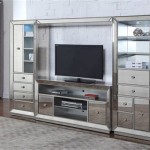TV That Is A Mirror When Off: Reflecting Innovation in Home Design
The concept of a television seamlessly blending into the home environment has long been a pursuit of designers and technologists. One innovative solution gaining popularity is the mirrored television. This technology allows a standard television screen to transform into a reflective surface when powered off, effectively mimicking a conventional mirror. This dual functionality provides both entertainment and aesthetic value, making it an attractive option for various interior design schemes.
The underlying technology behind mirrored televisions relies on a specialized type of partially reflective glass. When the television is on, light emitted from the display passes through the glass, allowing viewers to see the image. When the television is off, the display emits no light. Ambient light in the room is then reflected back from the semi-transparent mirror coating, creating the mirror effect. This dynamic shift between display and reflection is achieved without any mechanical parts, offering a seamless transition.
Several manufacturers offer mirrored televisions, utilizing slightly different approaches to achieve the desired effect. Some models employ a dielectric mirror, which uses multiple thin layers of optical coatings to selectively reflect and transmit light. This method typically results in a higher reflectivity when the TV is off, providing a clearer mirror image. Other models utilize a simpler, single-layer reflective coating, which may result in a slightly less reflective surface but often comes at a lower price point.
The quality of the mirror image is a key factor to consider when selecting a mirrored television. The reflectivity, measured as a percentage, indicates how much light is reflected back. A higher reflectivity percentage translates to a brighter and clearer mirror image. Additionally, the color accuracy of the reflected image is important. High-quality mirrored TVs strive to provide a neutral reflection, avoiding any color tints that might distort the reflected image.
Beyond the core technology, various features and design elements differentiate mirrored television models. Screen sizes typically range from standard television dimensions to larger formats suitable for commercial applications. The frame design also plays a significant role in the overall aesthetic. Some models feature minimalist frames that blend seamlessly with the mirror effect, while others offer more decorative frames to complement specific interior design styles.
Integration with smart home systems is another evolving aspect of mirrored televisions. Many models now offer compatibility with popular smart home platforms, allowing users to control the television and other connected devices through voice commands or mobile apps. This integration enhances the convenience and functionality of the mirrored television, further solidifying its place in the modern connected home.
The applications of mirrored televisions extend beyond residential use. In commercial settings, these versatile displays can be utilized in gyms, hotels, retail stores, and restaurants. They can display information, advertisements, or entertainment content when active, and seamlessly transition into a mirror when inactive, maintaining the desired aesthetic of the space.
The placement and installation of a mirrored television require some consideration. Similar to a conventional mirror, the placement should take into account the reflection of light and the surrounding environment. Avoid placing the television directly opposite windows or other bright light sources, as this can create glare and diminish the viewing experience. Professional installation is recommended for larger models to ensure proper mounting and wiring.
Cleaning a mirrored television requires a slightly different approach than cleaning a standard television screen. Harsh chemicals and abrasive cleaning materials should be avoided, as they can damage the delicate reflective coating. A soft, microfiber cloth dampened with distilled water is generally recommended for cleaning the surface.
The price of mirrored televisions varies depending on the size, features, and brand. Generally, they command a premium compared to standard televisions due to the specialized technology involved. However, as the technology matures and production scales increase, prices are expected to become more competitive.
Mirrored televisions offer a compelling blend of functionality and aesthetics. They represent a significant step forward in the evolution of home entertainment and interior design, providing a unique solution for those seeking to seamlessly integrate technology into their living spaces. As technology continues to advance, further innovations in mirrored television design and functionality can be anticipated.

75 Framed Samsung Led Mirror Tv Model Un75ju641

Disappearing Act Séura S Tv Mirrors Amaze Wolfers Lighting

Eclipse Tv Cover By Electric Mirror Tvc 43 Emr615297

Vanity Mirror Tv Vanishing Television For Your Bathroom

Tv Mirror Mirrorworld

Dielectric Mirror Stock Sheet Television

Led Mirror Tv Television When Off On Cornice Nascondere Spo

Any One Have Experience With The New Dielectric Or Mirror Tv

Mirror Tv

Samsung Mirror Tv Complete Television Guide








